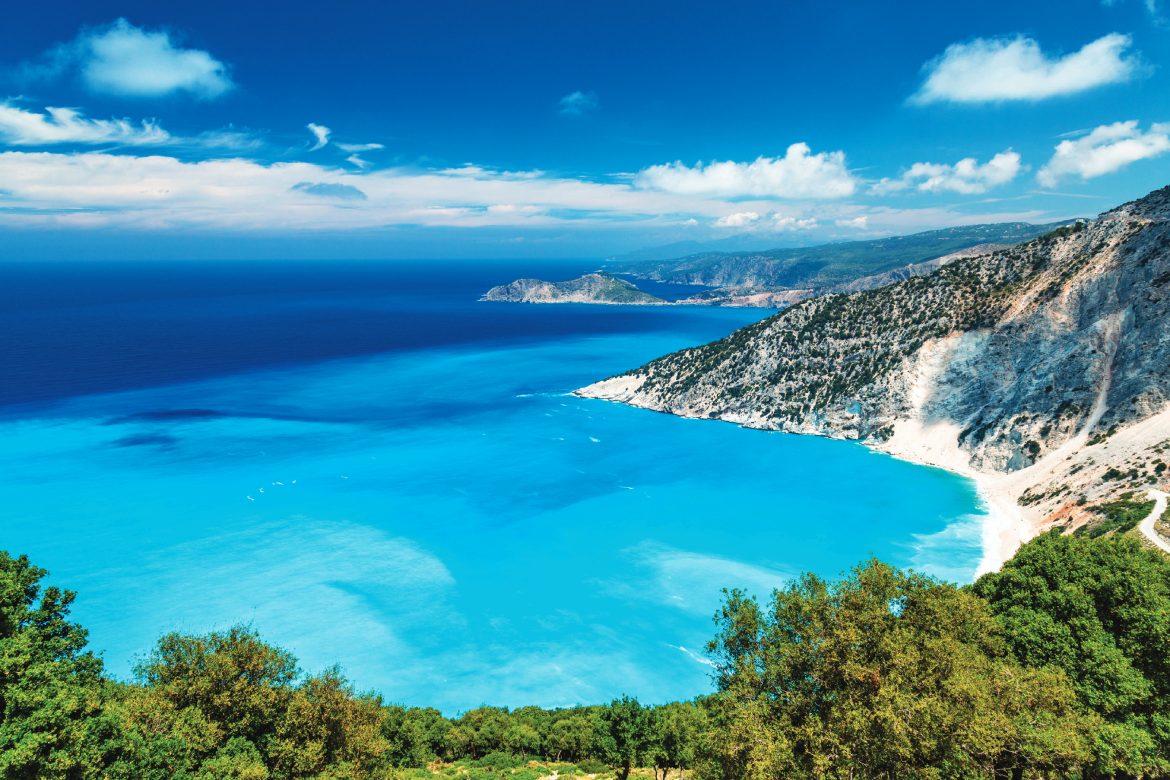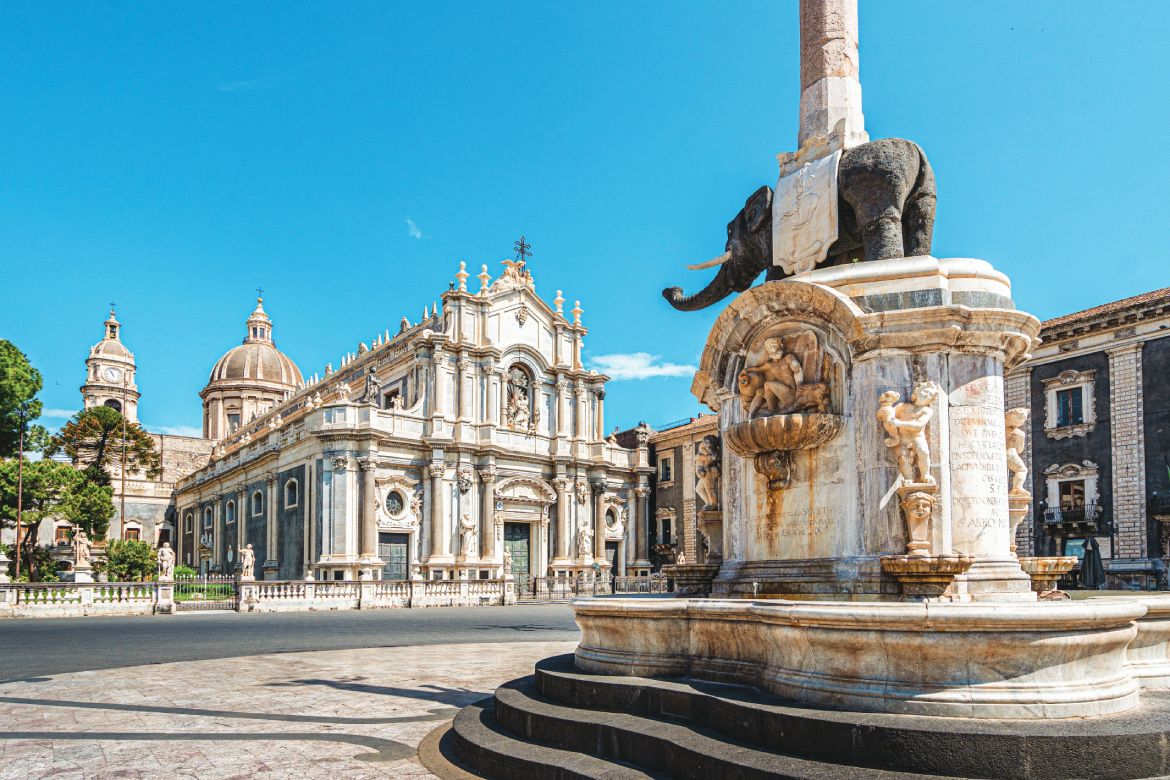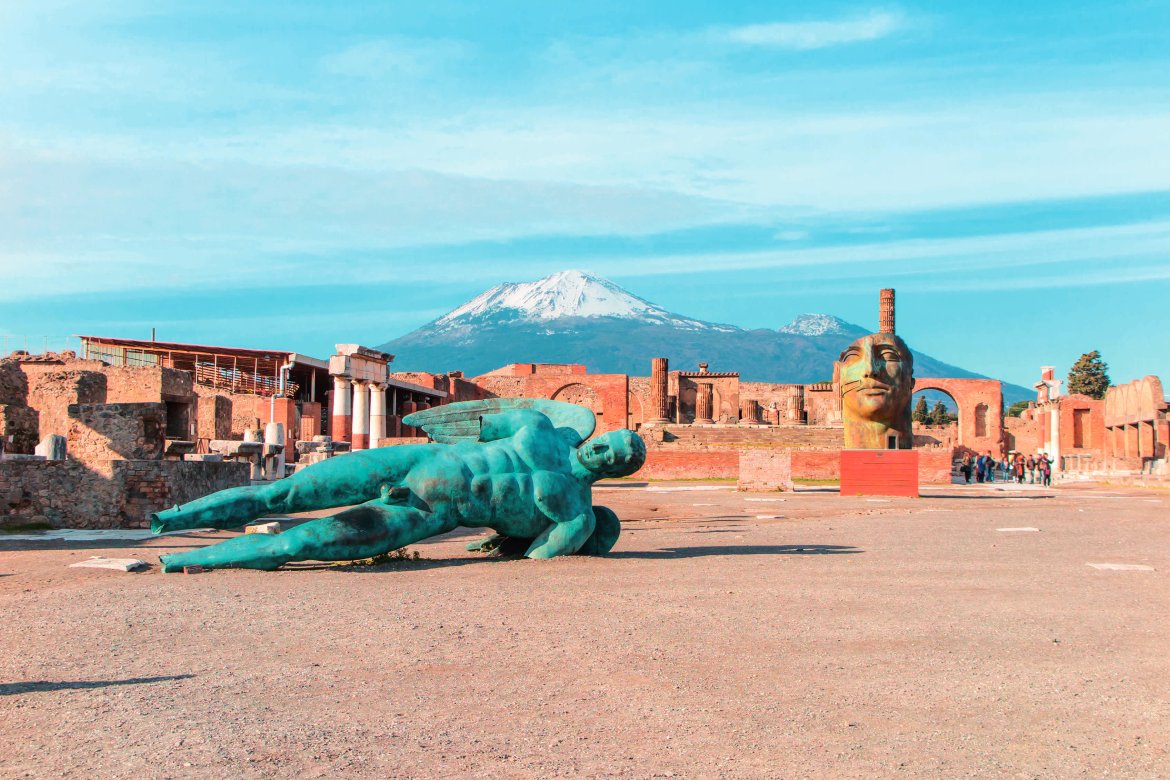Come with us on a luxury Mediterranean yacht cruise aboard the Emerald Azzurra that will take us from Athens to Rome via the Peloponnese, Sicily and Naples.
In the distance, Mount Etna transcends time. The volcano that’s marked the island of Sicily through the ages was the same sight for me as for Phoenicians, Greeks, Romans, and other travelers (some of them invaders).
As in millennia past, the cerulean water washed a blue tint over Etna’s green slopes, until finally the 21st-century Sicilian shore came into focus. As I cruised aboard the Emerald Azzurra that sunny Mediterranean morning, the legendary peak was thrilling to behold. We had departed the west coast of Greece the prior evening for a long stretch across the Ionian Sea. It felt like true travel to cross a broad passage by ship and to use Italy’s tallest peak for my own wayfinding.
The difference between my voyage and that of ancient explorers was modern luxury. Not that I’m afraid of roughing it, but after a few years away from cruising, the words “Mediterranean yacht cruise” felt irresistible. Even more so for an itinerary from Athens to Rome, via Peloponnese, Sicily, and Naples. These are my trigger words for pure travel delight.
The Azzurra is one of Emerald’s newest vessels, launched in 2022 and instantly earning Cruise Critic’s “Best New Luxury Ship” award. As a “superyacht,” the ship and its sister vessel the Emerald Sakura offer an intimate cruise experience with no more than 100 guests on board. Staterooms and suites are hotel room spacious, nearly all with balconies, and outfitted in high style that makes a passenger feel more like a VIP than an ordinary cruiser.
Built for savoring sea travel, the Azzurra was the answer to my yacht-trip yearning. The ship itself is as sleek as I’d imagine a new yacht could be, with an infinity pool and jacuzzi on its upper decks, a gym and a spa, the roomy Amici Lounge with fun nightly programming (music trivia or dance lessons, anyone?), and lovely La Cucina indoor or al fresco dining. In the Mediterranean, Caribbean, Seychelles, and beyond, the Azzurra’s custom routes reach ports accessible only to smaller vessels. So I could explore small towns and quiet beaches on my own by foot or driving Emerald’s GoCycle electric bikes, or by joining cruise-organized, locally led tours.
One of the most yachty elements, however, was feeling carefree for all eight glorious days—from airport transfers and snappy WiFi, to cocktails and gratuities, to splendid meals paired with regional wines. All was taken care of through the impeccable service of the Azzurra’s 76 crew members, and all of it was attractively priced for travelers like me to spend smart on Emerald luxury.
Splendor also extended beyond the yacht, as this part of the world that sees sunshine upwards of 250 days per year. One could easily spend each day gazing from the observation lounge or sipping Aperol spritzes at the Sky Bar, but that might mean missing on-shore tales of Greek legends, local architecture lessons, or a tour of Pompeii followed by pizza in Naples.
My cruise embarkation followed two nights of reacquaintance with Athens, a city that’s manageable in size, with good neighborhoods to stroll through that always seem to lead to an ancient or otherwise marvelous spectacle. As the birthplace of democracy, one might think Athens is somehow elite or unapproachable.
This world capital, however, has a natural human character and scale, with a bit of a grubby streak that reminds me of New York, where native locals, repeat visitors, diverse immigrants, and packaged tour-bus crowds manage to live together in their own special way.
After some sightseeing and about eight different stops for my favorite Greek delicacy, spanakopita (all of them delicious!), my quick Athens visit gave way to Emerald’s pick up at Syntagma Square’s polished NJV Plaza Hotel (2 Vasileos Georgiou A. Tel: 210-335-2400. njvathensplaza.gr) bound for Piraeus Harbor. As we shipped out of Athens a double rainbow appeared, an auspicious sendoff for the days ahead.
One of my favorite parts of any cruise is waking up to a new sight each morning. This day it was to Gythio, a small harbor town on the southern coast of Peloponnese. Some of my shipmates set off for Emerald’s tour of the Museum of Olive Oil in Sparta, but I couldn’t resist a Greek cooking demonstration in town. After the tasting the freshest feta and tomatoes and olives, and of course a sampling of Greek ouzo, I joined a few new friends for a walkabout. The water was clear enough to see fish 10 feet down, flaunting their freedom around the moored fishing boats and taunting a clowder of cats on shore.
By that afternoon, the Emerald Azzurra was cruising again under the Mediterranean sun, this time to Cephalonia (pronounced Kefalonia), the largest of the Ionian Islands. From the capital city Argostoli, we toured across the hills to the southwestern slope, overlooking the most brilliant azure waters I could ever imagine.

Myrtos Beach, Cephalonia (photo by Photo by Roman Safonov)
We reached the Melissani Cave, a cenote where two-thousand-year-old artifacts were discovered, including clay statuettes depicting the nature deities called Nymphs and the goat-footed Pan of Greek mythology. At the bottom of a long ramp, 10 of us climbed into a rowboat where a rotund Greek man, gnawing on a cigar, paddled us to the edge of a lake cave 70 feet below the surface. Our oarsman spoke no English, so he sang for us in Greek, his echo rippling forth from the limestone cavern.
Then across the Ionian Sea we cruised, enjoying our superyacht’s refined cocktail service on the sky deck, on loungers, or soaking in the bow’s oversized jacuzzi. Each day’s breakfast and lunch options were gourmet, and surprisingly international as I learned while obsessing over the amazing Indian curries and soups that were served among the lunch choices. Dinner in La Cucina’s sleek, white-tablecloth setting exceeded expectations, with a menu of “always available” appetizers, entrées, and desserts, and nightly changing dishes that included excellent fresh carpaccio, pasta and risotto, and local grilled fish.
BENVENUTO IN ITALIA
Midway through the cruise, Mt. Etna welcomed us to Catania, Sicily, recently made famous in The White Lotus season two— though much of it was shot in nearby Taormina. Fortunately, series fans were able to join Emerald’s “DiscoverMORE” tours (for a modest added charge) to see spectacular Taormina themselves with a stop for hilltop cocktails. But I had another DiscoverMORE priority with The Godfather tour. Yes, I love the film, and even though some of my shipmates thought it touristy, there was no way I’d miss seeing some of the Sicilian shooting locations used throughout the trilogy. We drove up the hills to the Medieval village of Savoca, where we sampled authentic limoncello granitas at Bar Vitelli and reimagined Michael asking the owner about Apollonia. We visited San Nicoló Church, where the couple marry and begin their nuptial procession down the cobblestone lane.
A short bus ride later, we arrived at the ultimate Godfather fan site, the 17th-century Castello Degli Schiavi in Catania’s Fiumefreddo area. Cinephiles know it as Don Tommasino’s villa, where Michael teaches Apollonia to drive, among other pivotal scenes. For a film lover like me, this was a highlight location complete with firsthand stories from the villa’s enthusiastic, legacy owner, Baron Franco Platania, who consulted in person with Francis Ford Coppola on the set of all three shoots. About a dozen of my shipmates joined the tour, though only a couple of them had seen The Godfather. Yet all of them loved this unique experience visiting Savoca, the villa, and the filming and family stories from our Emerald guide and the Baron Platania.
A second day in Catania introduced us to more of the city’s rich and sometimes sordid history. Our tour guide Nunzio eagerly educated us about the Baroque architecture, buildings, and monuments made partly of black lava stone (a gift from Mt. Etna), and how the elephant is a symbol of Catania for its wisdom, tough dark skin, powerful protection, and proximity to Africa.
The famous Elephant Fountain marks Catania’s central Piazza del Duomo, where the Cathedral of St. Agatha stands. St. Agatha is the city’s patron saint, a martyr, and virgin who was tortured and killed by the Roman prefect in 251 A.D. when she refused his advances and remained loyal to Christianity. Nunzio then told us about a young Catanian woman in the 13th century named Gammazita. She was engaged to marry a local man, until a French soldier increasingly imposed himself on her.


Elephant Fountain and the Cathedral of Saint Agatha (Photo by Lomb)
Rather than lose her honor, she threw herself down a well in the city center. Today that well is lightpost, with a bronze statue of Gammazita diving headfirst. Catania was a hard place, especially for women, but it is good to know that the local community still commemorates those who suffered.
Today, Catania is a bustling city of more than 300,000 residents that’s seeing a surge of visitors curious about the region’s rich history, culture, and food. Years ago I visited Catania, and ever since have reported to anyone who’ll listen about two specific Sicilian edibles. The first is the citrus, specifically giant navel oranges so perfectly flavorful and juicy. The other is arancino (translation: orange), a hearty, tasty risotto ball filled with a scoop of ragu that’s battered and fried. Luckily, Nunzio sent me to Prestipino (Piazza del Duomo 1. Tel: 333-196-3333. prestipino.shop) for one of the city’s best arancini. Whether fried and savory or tangy and ripe, always try the oranges of Sicily.
Cruising into the Bay of Naples was especially memorable because I joined our Azzurra captain and crew on the bridge, something every guest is invited to do throughout the voyage. We saw the hills come into focus as our superyacht found its dock between the ferry, cargo, and cruise vessels.


Naples and Mount Vesuvius (Photo by Sergii Figurnyi)
The words ‘Mediterranean yacht cruise’ felt irresistible. Even more so for an itinerary from Athens to Rome, via Peloponnese, Sicily, and Naples.
I had heard a lot about this busy, loud, pizza-loving city and was eager to get to know it. Emerald escorted passengers from the port to the city center, where we toured on foot past the Royal Palace, National Library, famous Teatro di San Carlo, and Galleria Umberto I, a shopping hub with a towering skylight (similar to Milan’s Galleria Vittorio Emanuele II). We soon boarded a bus for a tour of the greater metropolis, taking in cliffside views and seeing just how wild Napolitano drivers and motor-bikers can be. (Yes, be very careful crossing streets, and walking on sidewalks for that matter.)
As night fell, I set out for two recommended spots in town. For aperitivo time (Italian happy hour), the hotspot in town is Barrio Botanico (Via Medina 24. Tel: 081-424-6186. facebook.com/barriobotanico), a fabulous scene for signature cocktails and nibbles in the courtyard of the Casa del Contemporaneo performing-arts space. Conveniently, nearby is Trattoria Medina (Via Medina 43.Tel: 081-551-5233. trattoriamedina.it), my hot tip for pizza, which was delicious along with a light local red wine, perfetto from my terrace table. I’ll remember both gems when I return someday to Naples, hopefully for its annual June Napoli Pride (napolipride.org).
For our glorious Mediterranean cruise finale, at last I got to visit Pompeii, a missing destination in my Italian explorations and love of history. Our tour bus arrived by midmorning and already this UNESCO World Heritage Site was booming with travelers filing past souvenir stands and through the ticketed turnstiles. What little I knew of or imagined about Pompeii was quickly overshadowed as I stood among the ruins dating as far back as 450 B.C. I saw the actual Roman roads and amphitheater, the kitchens and water wells, the columns and statues, plus everything from ornate altars to a mosaic-clad brothel.


Pompeii, Italy (Photo by Muratart)
It was a gray day that turned chilly, and as dark clouds passed overhead, there was an ominous sense that Mt. Vesuvius, whose volcanic eruption and scorching ash destroyed and preserved Pompeii as it stood in 79 A.D., reigned still over this region. On one hand, the story is bleak; on the other, this ancient settlement is a boundless source of human history and learning.
We departed Naples and cruised toward Rome’s Port of Civitavecchia, itself dating to the 7th century B.C. I felt the past merge with present and future, the way the sea holds time in its ebbs and flows. My cruise had inspired a voyage of discoveries, and so much of what was new to me was ancient history.


